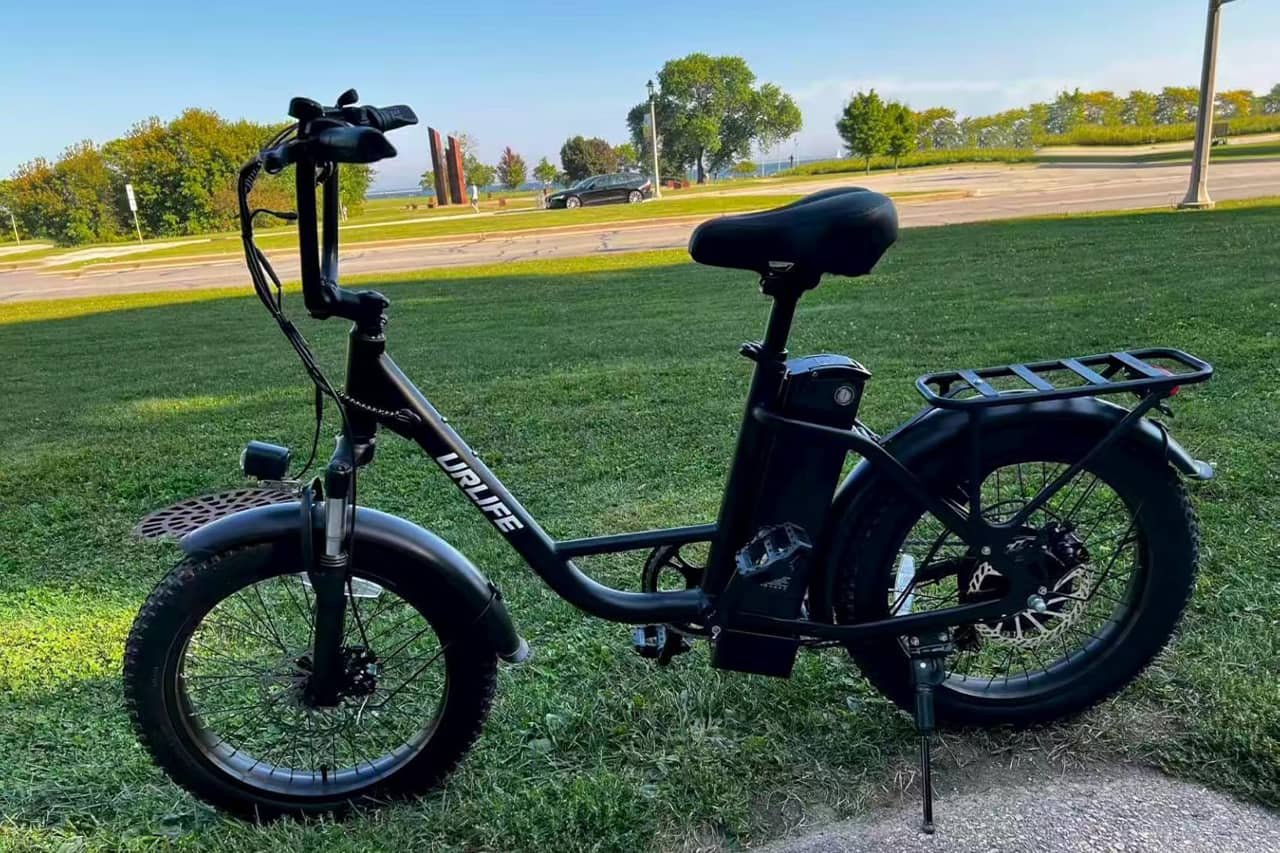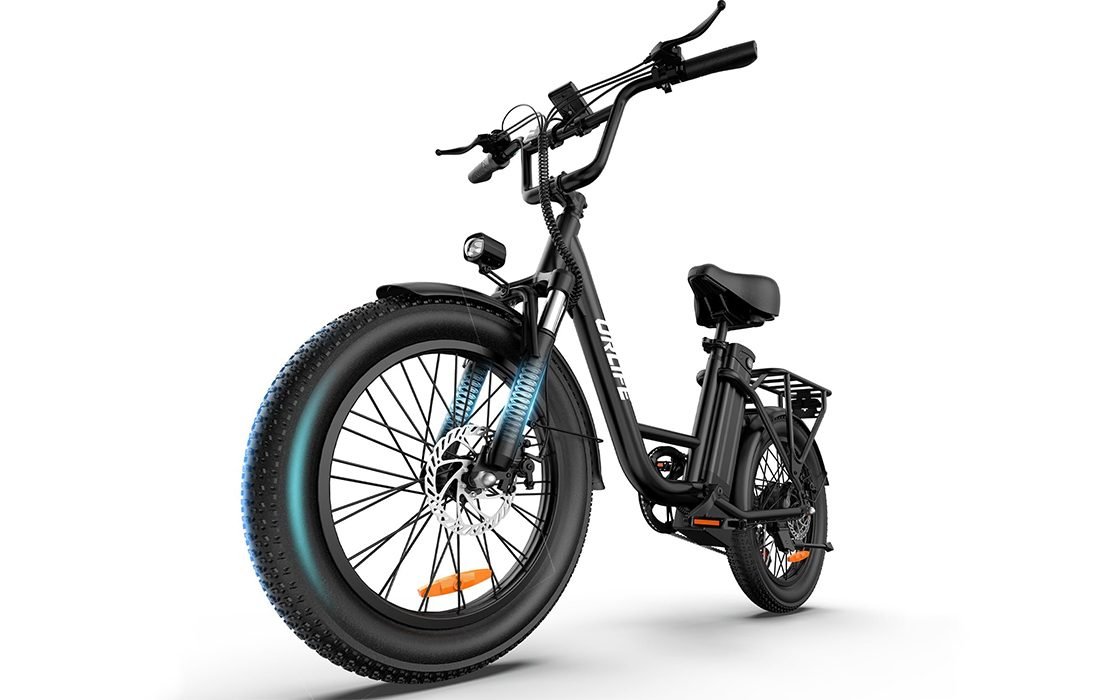
URLIFE E20 Review: Great Value Comfort Commuter—With Limits
Easy step-through and rack utility for daily rides, but speed claims and budget braking “polish” are the real trade-offs.
Tested: commute-style rides + errands. Rider: 5′10″, ~180 lb. Best fit for: city pace, comfort, utility.
- Best for: short-to-medium commutes and everyday errands.
- What you’ll like: comfortable step-through ride + practical rear rack.
- Trade-off: not a true “fast/hilly” bike—budget feel shows when pushed.
The URLIFE E20 is a 20-inch, step-through, “compact fat-tire” style e-bike built for casual commuting, errands, and weekend cruising without spending much. The big headline here is value: you’re getting a rack-equipped step-through frame, front suspension, lights, and a removable battery at a very low price.
I tested it the way most owners actually ride—short trips, stop-and-go streets, a few rough patches, and some mild hills—because that’s where a budget e-bike either feels surprisingly usable… or annoying. The E20 lands closer to “useful daily tool,” as long as you understand what it is and what it isn’t.
If your goal is one bike that’s easy to mount, easy to live with, and good enough for typical city speeds, the E20 can make a lot of sense. If you want true high-speed riding, steep-hill dominance, or premium braking and refinement, you’ll hit the ceiling fast.
Quick Verdict
One-sentence verdict: A strong choice for budget commuters and casual riders who want an easy step-through and a rack, but not ideal if you need real high-speed performance or premium braking confidence.
Best for:
- Short-to-medium commutes and errands where comfort matters more than speed
- Newer riders who want an easy step-through mount and stable 20″ handling
- Value shoppers who want “the basics done right” at a low price point
Not ideal for:
- Riders with steep hills every day (long climbs will expose its limits)
- Anyone expecting consistent ~28 mph riding or e-moto power
- Riders who prioritize high-end brakes, refined pedaling feel, or ultra-light weight
Biggest strength: Comfort + practicality for the money (step-through + rack + simple, confidence-inspiring ride).
Biggest trade-off: Performance and “polish” (especially speed claims, braking feel, and overall refinement).
Scorecard
- Ride Feel: 7.6/10
- Power (Real Use): 7.2/10
- Range (Real Use): 7.0/10
- Comfort: 7.8/10
- Build & Serviceability: 6.6/10
- Value: 8.6/10
At a Glance
- Category: Budget step-through commuter / casual cruiser
- Motor: Brand advertises up to 1000W peak (real-world feel: adequate for city riding)
- Battery & Range: 48V 13Ah removable; claimed up to 80 miles (realistic range is notably lower for most riders)
- Top Speed / Class: Marketing is inconsistent (I’d treat it like a “city-pace” e-bike, not a guaranteed high-speed machine)
- Weight & Payload: Steel frame; rear rack; brand mentions a 265 lb load claim
- Sensor + throttle behavior: Feels like a budget cadence-style tune (simple, not “bike-like”)
- Best for: Comfortable short commutes, errands, and relaxed weekend rides
Real-World Test Setup
- Rider: 5′10″, ~180 lb, regular e-bike rider
- Terrain: Mixed pavement, bike lanes, some cracked roads; a few short hills/ramps
- Load: Light backpack + occasional small errand load on the rear rack
- Assist usage: Mostly mid PAS for commuting pace; throttle used for starts and crossings
- Conditions: Normal city riding conditions; tire pressure adjusted for comfort vs rolling resistance
- Test duration: Multiple rides across the week (commute-style loops + errands)
What Is the URLIFE E20?
The E20 is designed to be approachable and practical: step-through geometry for easy mounting, 20″ wheels for stable low-speed handling, a front suspension fork to take the edge off rough pavement, and a rear rack for daily utility.
It’s also very clearly positioned as a budget model. That’s not automatically a bad thing—budget e-bikes can be excellent if the priorities are correct (comfort, basic reliability, simple controls). But it does mean you should expect a few compromises in refinement, parts feel, and consistency in performance claims.
Key Specs
| Spec | What’s listed / shown |
|---|---|
| Motor | Up to 1000W peak |
| Torque | 80 N·m |
| Battery | 48V 13Ah, removable |
| Claimed range | Up to 80 miles (highly conditional) |
| Speed | 15.5 mph top speed |
| Tires | 20″ × 3.0″ |
| Suspension | Front fork suspension |
| Drivetrain | 7-speed |
| Brakes | Dual disc brake |
| Display | Color-style LCD; IP54 |
| Lights | Front/rear lighting |
Who This Bike Is For
This bike makes the most sense for riders who want an easy step-through e-bike for day-to-day stuff: commuting a few miles, riding to stores, cruising with friends, or handling light errands without arriving sweaty.
The ride character is confidence-first. The smaller wheels and upright stance make it feel predictable in tight spaces, and the step-through frame is genuinely convenient if you’re mounting frequently (stoplights, errands, casual rides).
If your definition of “does it all” means city riding + comfort + utility at low cost, the E20 fits. If “does it all” means fast, steep hills, heavy loads, and premium control, that’s where you’ll want to look elsewhere.
Who Should Skip This Bike
Be blunt here—this section saves returns.
- Skip if you ride steep hills daily → You’ll be happier with a stronger hill-focused setup (often mid-drive, better gearing, and higher thermal headroom).
- Skip if you expect consistent 28 mph riding → The marketing is inconsistent; treat this as a practical commuter, not a guaranteed high-speed machine.
- Skip if you want a bicycle-like pedaling feel → Budget tuning often feels more “on/off” than natural, especially in stop-and-go.
- Skip if you need premium braking confidence → “Dual disc” doesn’t automatically mean strong braking feel; if you’re heavier, ride fast, or ride in wet conditions, prioritize higher-end brakes.
Real-World Performance
1) First Ride Impressions
The first thing I noticed was how easy it is to live with. Mounting is genuinely effortless, and the overall posture is relaxed—more “commuter comfort” than “sporty bike.” For newer riders, that confidence matters.
The second thing I noticed: it rides like a budget e-bike in how assistance comes in. Not dangerous, but not refined. You learn quickly to ease into starts and not mash the controls like you would on a premium torque-sensor bike.
Surprise trade-off: the bike feels stable and comfy at “city pace,” but the moment you start chasing higher speeds, the whole experience feels less composed (especially with small wheels and budget components).
2) Power & Ride Feel
Starts (stop-and-go):
- Good at: Getting you moving quickly through intersections without drama.
- Cost/boundary: Assistance can feel a bit eager; I had to ride with a light touch at low speed.
Hills (short climbs):
- Good at: Short ramps and mild hills are fine with steady input.
- Cost/boundary: Long or steep climbs are where budget motors and tuning show limits—speed drops and it feels like it’s working hard.
Cruising (where it feels happiest):
- Good at: A relaxed cruising band—comfortable, upright, and stable.
- Cost/boundary: High-speed “stretching its legs” isn’t what this bike feels built for.
Pedaling beyond assist / battery off:
- Good at: It’s still rideable for short distances.
- Cost/boundary: You feel the weight and rolling resistance more than on a lighter commuter bike.
3) Speed & Control
Here’s the honest truth: the marketing around speed is mixed, and the ride feel matches a budget commuter more than a true fast bike. I wouldn’t buy this model specifically for top-speed bragging rights.
What I did like is control at normal city speeds—tight turns, curb cuts, and weaving through slower areas felt manageable. It’s a “ride it daily” type of bike, not a “push it to the edge” type.
4) Range You Can Expect
The battery is 48V 13Ah, and the listing claims up to 80 miles. In real life, that number usually requires low speed, lots of pedaling, flat terrain, and conservative assist.
My practical expectations for most riders:
- Conservative: ~35–50 miles (lower speeds, lighter assist, flatter routes)
- Typical: ~20–35 miles (mixed riding, moderate assist, normal stops)
- Aggressive: ~12–20 miles (higher assist, more throttle, hills, heavier loads)
Top range killers on this bike: speed chasing, hills, and tire pressure/rolling resistance.
Translate to life: If your round-trip commute is ~6–10 miles, you’re realistically looking at multiple commute days per charge under moderate use.
Comfort, Handling & Practicality
Comfort (What my body noticed)
For the price, comfort is a real win. The upright position and step-through layout reduce that “I’m perched forward” feeling that some budget commuters have. The front suspension helps on cracks and uneven pavement, and the 3.0″ tires add a little cushion if you don’t overinflate them.
That said, comfort is always adjustable. I got the best feel by dialing tire pressure for my weight and choosing a moderate assist level so the bike wasn’t lurching in traffic.
Handling & Stability (low and higher speed)
Low-speed control is a strength. I could U-turn without feeling like I was wrestling the bike, and it’s easy to walk through doors or around tight storage areas.
At higher speeds, the smaller wheels and budget setup feel less planted than a bigger-wheel commuter. It’s not scary—just not the bike I’d pick for consistently fast riding.
Brakes & Safety (confidence, not specs)
The listing says “dual disc brakes,” but the type matters a lot. On a budget bike, you should assume you’ll want to check brake adjustment early and often.
My safety advice: after the first few rides, re-check brake lever feel, caliper alignment, and rotor rub. If you want more stopping confidence (especially if you’re heavier, ride fast, or ride wet roads), upgrading pads—and eventually the braking system—can be a smart move.
Practicality
The rear rack changes the daily usefulness. It’s the difference between “fun ride” and “actual transportation.” Grocery runs, gym bags, small work loads—this is where the E20’s value becomes obvious.
Controls, Display & Riding Modes
The display style shown is a color LCD, and it’s easy to understand at a glance: speed, battery level, assist. In real riding, that’s what I care about—quick readability, not fancy app features.
The lighting is a plus for basic visibility, but I still recommend a separate brighter light if you regularly ride in dark streets. Budget integrated lights are typically “be seen,” not “light up the road.”
Fit, Sizing & Adjustability
At 5′10″, I had plenty of room to get comfortable, and the upright cockpit felt natural for commuting and casual rides.
- For shorter riders: Step-through helps a lot, but check reach to the bars and whether you can get the saddle low enough for confident stops.
- For taller riders: Make sure you can get full leg extension without maxing the seatpost. Also consider whether the bar height feels cramped.
Tuning tips that actually matter:
- Lower tire pressure slightly for comfort (without going squishy)
- Slightly rotate bars to reduce wrist pressure
- Adjust saddle fore-aft so you’re not sliding forward under braking
Ownership Notes
Assembly
It’s advertised as mostly pre-assembled, and that matched my experience. The time sink isn’t “hard steps,” it’s the small details: straightening bars, checking bolts, dialing brakes, and making sure nothing rubs.
First-week checklist (do this after 10–20 miles)
- Re-check axle nuts / wheel seating
- Re-tighten handlebar and stem bolts
- Adjust brakes (rub and lever feel change after bedding in)
- Check tire pressure and sidewall condition
- Inspect chain tension and shifting smoothness
Service reality
Wear items are typical: brake pads, chain, tubes/tires. The practical advantage here is that these are common bicycle parts—just don’t assume “disc brakes” means “no maintenance.”
What’s Included in the Box
- E-bike + charger
- Basic tools and manuals (typical for this category)
- Rack and lights appear to be part of the standard setup (verify your exact package)
Pros & Cons
Pros:
- Step-through frame is genuinely easy and confidence-inspiring
- Comfortable upright posture for commuting and casual rides
- Rear rack adds real everyday usefulness
- Stable low-speed handling with 20″ wheels
- Front suspension and 3.0″ tires reduce harshness on rough pavement
- Strong value if you want a practical budget commuter
Cons:
- Braking feel and adjustment needs are typical budget-bike reality
- Steel frame + commuter build can feel heavy in stairs/rack lifting situations
- Assistance feels less refined than torque-sensor commuter bikes
Deal-Breakers & Annoyances
- For commuters: If you need consistent fast traffic-matching speed, the E20 isn’t the safest bet—treat it as a city-pace bike.
- For apartment storage: If you carry bikes up stairs often, weight and bulk can become a daily frustration.
- For hills: If your route includes long climbs, you’ll feel power drop and effort rise—choose a hill-priority bike instead.
- For riders who want “bike-like”: If you hate assist that feels a bit “digital,” you’ll prefer a torque-sensor commuter.
FAQ
Is it good for hills?
It’s fine for mild hills and short ramps. For long, steep climbs every day, I’d skip it and shop specifically for hill performance.
Is it comfortable for longer rides?
Yes, within its design intent. The upright posture, front suspension, and 3.0″ tires help—just don’t overinflate the tires.
Can shorter riders fit it?
The step-through helps a lot, but fit depends on seat height range and reach. Make sure you can comfortably put a foot down at stops.
Is the battery removable / easy to charge?
Yes—removable is a practical win for apartment living and office charging.
How long does charging take?
The listing suggests a fast charge window, but real charge time depends on the charger output. Plan for “a few hours,” not “instant.”
What maintenance should I expect?
Brake adjustment after bedding-in, chain lubrication, tire pressure checks, and normal wear items (pads/chain/tubes).
Is it safe / does it have verified certifications?
I would not assume any certification unless it’s explicitly verified in the listing documentation. Ride defensively and prioritize brake setup.
What’s the first upgrade you’d do?
If braking feel isn’t confidence-inspiring, start with better brake pads and proper adjustment. After that, consider comfort touchpoints (saddle/grips).
Final Verdict – Should You Buy It?
Buy it if: You want a comfortable, step-through, rack-equipped budget e-bike for short commutes and daily errands.
Skip it if: You need high-speed consistency, steep-hill strength, or premium braking/refinement.
Best use case: City commuting at a sensible pace + weekend cruising + practical errands.
Main compromise: It’s a budget bike—performance claims and component “polish” won’t match higher-tier commuters.
Would I spend my own money on it? At this price, yes—if my goal is a simple, comfortable utility e-bike and I’m not expecting it to ride like a premium commuter or a high-speed machine.
| Preview | Product | Price | |
|---|---|---|---|
|
|
URLIFE 20″*3.0 Fat Tire Electric Bike for Adults, 48V Removable Battery, 80-Mile, 7-Speed &… | $399.99 | View on Amazon |




![isinwheel U8 Plus Review ([year]): Comfort, Torque & Real-World Performance isinwheel U8 Plus Review: Realistic Range, Speed, and Buying Mistakes](https://goebikelife.com/wp-content/uploads/2025/12/isinwheel-U8-Plus-Electric-Bike-Review-768x512.webp)
![MACFOX X1S Review ([year]): 750W Fat-Tire Mini Ebike with Dual Batteries MACFOX X1S Electric Bike Review: Wheelie-Ready Fun for Street Riders](https://goebikelife.com/wp-content/uploads/2024/12/MACFOX-X1S-Electric-Bike-for-Adults-768x512.jpg)



